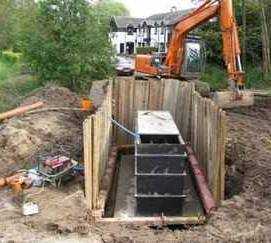Sewage Treatment Plant Installation & Repair | WTE
This installation information is for all makes of sewage treatment plants, septic tanks and septic tank conversion units
Please read this general Guide to the Installation of Sewage Treatment Plants.
Correct installation is ESSENTIAL. See here for steps to take for a sewage treatment plant installation.
DEWATERING THE INSTALLATION SITE
Mention “dewatering” to contractors outside of the underground construction trade, and typically, they have no idea what you are talking about. Mention dewatering to anyone in the underground construction trade, and they’ll tell you that it is one of the most important aspects of the installation, as a well designed and installed dewatering system will allow them to complete their project in a safe way and prevent disastrous unforseen expense due to flooding, running sand, distorted or cracked tanks, etc.
 Groundwater exists at various depths below ground level, and in simple terms, dewatering is the lowering of the existing water table so that current work can be done below this depth, concrete backfills can 'cure' and tanks can be installed without any later damage due to higher future water tables. If the water table is above the level of the base of the excavation, then de-watering the site is essential both during and after the installation until the concrete is fully cured.
Groundwater exists at various depths below ground level, and in simple terms, dewatering is the lowering of the existing water table so that current work can be done below this depth, concrete backfills can 'cure' and tanks can be installed without any later damage due to higher future water tables. If the water table is above the level of the base of the excavation, then de-watering the site is essential both during and after the installation until the concrete is fully cured.
It is essential that your installer excavates a Trial Hole to the depth of the installation in advance of the installation itself to determine the depths of both the current water table and the maximum winter water table. If the water table is higher than the base of the excavation and your installer has any concerns, specialist advice should be sought as to the design and specification of the site specific installation. If your installer decides to design the installation himself, then it is his full liability should things go wrong as a result.
The lowering of the groundwater table can be achieved by different types of dewatering systems (note the side sump and pump in the photo above) and the type of installation is directly dependent upon the soil type and the soil’s permeability (ability to pass water through pore spaces).
Soils can range from:
- Highly permeable, such as coarse sands and gravel that will allow for the pumping of high volumes of groundwater
- Low permeability, such as silts with lower groundwater pumping ability
- Impermeable soils, such as clays
The type of system or systems installed will vary depending on the excavation depth, size and type or types of soil present at the site. When it comes to dewatering, one size does not fit all and many UK general builders do not have a clue about it.
It is essential that your groundworking crew know what to do BEFORE they meet groundwater problems that can ruin any sewage treatment system installation.
INSTALLATION REGULATIONS
Always insist that the installer knows the regulations that apply to sewage plant installations:
- The BS 6297 2007 +A1 2008
- Section H2 of the Building Regulations and insist on seeing their copy of both
- The Environment Agency General Binding Rules
You would be amazed how many installers have no idea that these regulations even exist, so how can they install the system correctly?.
WTE has many years of experience of all types of sewage installations and we can help the customer in chosing the right wastewater system or sewage treatment plant for the particular site. This involves a site survey, Trial Site Assessment Hole, percolation tests, considering the quality of the discharge that is required, the visual and audible impact, the purchase price, and the installation and running costs. The customer can then choose a system with confidence. Ring us on 01759 369915 and we will help you choose the RIGHT sewage treatment system for your site and use.
After choosing the sewage system, the location is carefully marked out together with the drain runs. The customer is made fully conversant with the proposed system to make sure they are fully aware of all aspects of the job.
Prior to any work starting, we recommend taking photographs of the site. Also before work starts, flowers and shrubs should be dug up and kept for re-planting.
Once work has commenced, we liaise with customers at all stages of the installation.
On completion, the site is reinstated to its previous condition, if required.

Children playing in the River Darent
Keep our rivers safe for our children
Servicing of all makes of sewage treatment plants - We recommend Sapphire Environmental Ltd.
